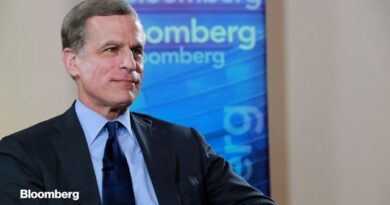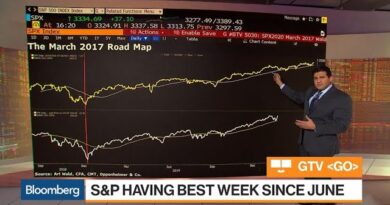
Debt Markets Priced for Perfection Risk a Stumble

(Bloomberg) — Investors flush with cash are embracing credit, moving up the risk curve in the rush to lock in high yields before the Federal Reserve finally begins to cut interest rates.
Most Read from Bloomberg
Money is flowing into junk bonds again and high-grade funds just saw the largest weekly inflow since September 2020, according to Bank of America Corp. That’s 19 weeks in a row that investment-grade products saw a net influx of money, strategists including Michael Hartnett wrote in a note.
The wave of new cash means bond managers are saying it would take a U-turn from the Federal Reserve on interest rate cuts to cause sentiment to turn negative. Even if they aren’t fully comfortable with the reward for taking risk at the moment, there aren’t many other options than to trust that a rotation out of money funds and into debt could cause spreads to narrow even further.
Read More: Credit Markets Are Acting Like Easy Money Era Never Ended
“Price action is typical of the end of the bull run in credit markets,” said Jose Mosquera, chief investment officer at Madrid-based hedge fund Quadriga Rho Investments Multi-Strategy in relation to pricing in Europe. “Investors are moving further down the credit spectrum into less-frequent borrowers.”
Here are five charts that show what’s happening in debt markets:
Fed Risk
At the moment, the biggest risk for credit “is that the Fed and all other central banks walk back totally the interest rate cuts that they’ve indicated to us already,” said Richard Hodges, who manages the global dynamic bond fund at Nomura Asset Management. Traders have been paring their expectations for interest rate cuts by the Federal Reserve this year, as more US data releases show the continued resilience of the economy. While Chair Jerome Powell suggested on Thursday that the central bank is getting close to the confidence it needs to start lowering benchmarks, the pace and size remains uncertain.
Story continues
New Money
Inflows into investment-grade debt are at their highest for the start of a year since just before the pandemic, helping to drive spreads narrower. A small rotation out of money market funds, which currently hold more than $6 trillion, and into credit would drive those tighter still, according to Hodges.
“You only need a smaller percentage to come out and that will be sufficient as people have a fear of missing out of the yields in bonds,” he said, adding “spreads can probably get tighter than you would ever imagine” because of the weight of money being invested.
Credit Risk Appetite
Sales of junior-ranking debt from European peripheral nations this week offered ample evidence of the reach for returns. Investors placed orders that were more than three times the €250 million ($272 million) of junk-rated tier 2 bonds issued by Portugal’s Banco Montepio. The securities paid a yield above 8.5%, almost double the average yield of the bonds included in a Bloomberg index grouping such kind of notes. Italian lender Banca Popolare di Sondrio received orders for more than five times the amount on offer in a similar sale, according to people with knowledge of the matter.
Junk Spreads Tighten
The extra yield offered to buy junk-rated debt tightened in recent weeks to some of the lowest levels since early 2022, before Russia invaded Ukraine and before the Fed and the European Central Bank started their interest rate hikes. Yields for the riskiest part of the market, CCCs, fell below 12% this week in the US for the first time this year.
Shrinking Distress
Even troubled debt is benefiting from the broad-based rally, with the amount of distressed corporate bonds and loans dropping more than 7% globally since early January. In the US, it has fallen almost 10% in the same period to below $198 billion.
Click here to listen to a podcast about credit paying “equity-like returns”.
Week in Review
-
Bond investors have punished banks with heavy exposure to commercial real estate, potentially adding even more pressure to the lenders’ profits as Wall Street scrambles to assess how widely pain in property debt will spread through the financial system.
-
D.E. Shaw is among hedge funds buying exposure to so-called blind pools of risk sold by banks looking to reduce their regulatory burdens.
-
A bank group spearheaded by Morgan Stanley held discussions with Elon Musk and his team about refinancing a roughly $12.5 billion debt package that supported the tech billionaire’s take-private of the social media platform X.
-
Wall Street bankers looking to raise fresh financing for multi-billion dollar buyouts are getting a boost from the record start to the year from a critical part of the leveraged loan universe.
-
A group of banks led by JPMorgan Chase & Co. launched a $4 billion leveraged loan sale to support Stone Point Capital and Clayton Dubilier & Rice’s buyout of Truist Financial Corp.’s insurance business.
-
The hype around artificial intelligence has revived a market oddity that many presumed dead with the global rise in interest rates: investors are once again paying for the privilege of owning certain bonds.
-
China’s local government financing vehicles are finding it a lot harder to issue bonds, as authorities step up efforts to curb risks from the debt-laden sector in a slowing economy.
-
European high-yield bonds are currently more attractive than their US counterparts in terms of valuation, according to Axel Potthof, senior portfolio manager at Fisch Asset Management.
-
David Roberts, a bond market veteran who built several billion-dollar funds from scratch over the past 27 years, is cutting his retirement short and buying debt again. His approach is “No AT1s. No CCCs.”
-
Ardonagh Group Ltd.’s $3.3 billion loan involved as many as 24 lenders, among the most seen in such a private credit deal, showing the size of syndications is expanding as more players want to get into a hot market.
-
BlackRock Inc. is forecasting rapid growth for transactions that allow banks to shed risk in their loan portfolios as tougher capital rules take hold.
On the Move
-
Goldman Sachs Group Inc. named banker Jonathan Fine to head its global investment-grade debt business, one of three appointments within the Wall Street firm’s financing group.
-
U.S. Bancorp appointed Bill Mulvihill to head the firm’s loan capital markets division, succeeding Jeff Stuart, who is retiring after 15 years at the company.
-
Lloyds Banking Group Plc said it has named Hayley Basterfield as managing director and global head of bond syndicate and liability management.
-
Mediolanum International Funds Limited has hired Daniel Loughney as head of fixed income, replacing Charles Diebel.
-
Banco Santander SA has recruited Credit Suisse’s Italian chief of investment banking and capital markets, Michele Pangrazzi, as head of industrials Europe.
-
Mizuho Financial Group Inc. has hired Andrei Irimia to work on its financial institutions debt syndicate desk and EMEA liability management.
–With assistance from Abhinav Ramnarayan, Olivia Raimonde, Michael Msika and Alice Gledhill.
Most Read from Bloomberg Businessweek
©2024 Bloomberg L.P.


